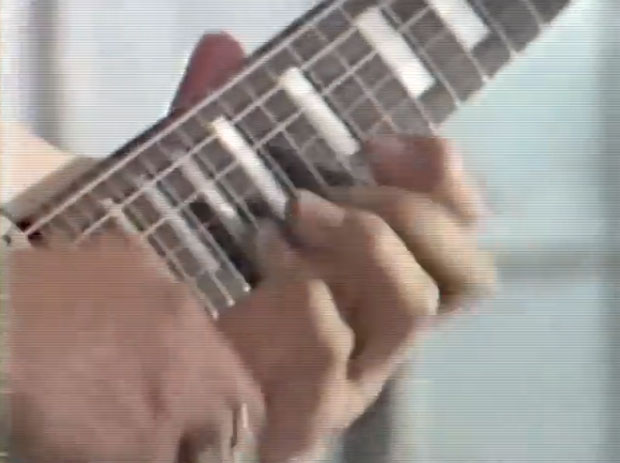Cracking the Code with Troy Grady: How to Play Vinnie Moore’s “Pepsi Lick”
An in-depth look at Vinnie Moore’s legendary “Pepsi Lick.”

Vinnie Moore is not only one of the most accomplished and respected players in rock guitar—he’s also a pioneer of instructional video.
In the wake of the Yngwie Malmsteen-inspired sea change toward picking technique virtuosity in the Eighties, Moore was one of the first players to gain prominence for his technical skill. Moore’s debut instructional video, Speed, Accuracy and Articulation, was one of the first close-up displays of picking-hand dominance available on home video.
It was a one-hour tour de force of effortless prog-fusion improvisation and pristine plectrum accuracy few could manage, yet it was delivered in Moore’s relatable, regular-guy style that made it approachable and inspiring. It was an instant instructional classic. Even more amazing is that Speed, Accuracy and Articulation was filmed in one straight take, with virtually no edits or re-takes, after a previous studio session left precisely one hour on the clock for the day.
As anyone who has filmed video lessons can attest, this is simply a super-human feat of on-camera consistency and cool-headedness. As it happens, this wasn’t Moore’s first time on camera. An early breakthrough in Moore’s career arrived in the form of a now-famous 1984 Pepsi commercial in which a guitarist bursts the caps off a crate of Pepsi bottles with nothing but the power of his searing shred.
The bottle-opening barrage of 16th-note triplets in the commercial is Vinnie’s, as are the fretboard hand closeups in the commercial. (Incidentally, the air-guitar acting in the wide shots is Honeymoon Suite’s Derry Grehan, also a great player.) The “Pepsi Lick” is a classic pattern which we came to know by the late Eighties as “descending sixes." And Moore’s second instructional video, Advanced Lead Guitar Techniques, featured a closeup look at exactly how the lick is played.
It turns out that a precise sequence of rotational picking movements is responsible for the accuracy of the intricate threading between the strings. Nearly invisible at normal video speeds, these “two-way pickslanting” movements become clear in slow motion—and more importantly, learnable and repeatable by the rest of us. At shred-level speeds, these movements become critical, as they are the most efficient way to move from one string to another.
And this is why you’ll see them in the techniques of all the great three-note-per-string masters, from Al Di Meola to Paul Gilbert. Check out the accompanying video lesson to see exactly how they work. Musically, Vinnie’s take on this venerable pattern is precise and gutsy, capped with a searing four-finger, bent-note shake on the phrase’s final note that drives the statement home in dramatic fashion. It’s a shining example of how musical drama can be created from even simple ideas with just the right mix of “Speed," “Accuracy” and, most of all, “Articulation."
For more on the amazing Vinnie Moore, check out the four-hour Masters in Mechanics Antigravity Seminar. Antigravity deconstructs the legendary accuracy of three-note-per-string masters like Vinnie Moore, Michael Angelo Batio, Paul Gilbert, Al Di Meola and John McLaughlin as never before. For the first time in an instructional format, we build a simple recipe of hand movements that explains exactly how these kinds of complex string-changing licks are played.
Troy Grady is the creator of Cracking the Code, a documentary series with a unique analytical approach to understanding guitar technique. Melding archival footage, in-depth interviews, painstakingly crafted animation and custom soundtrack, it’s a pop-science investigation of an age-old mystery: Why are some players seemingly super-powered?
Get The Pick Newsletter
All the latest guitar news, interviews, lessons, reviews, deals and more, direct to your inbox!
Troy Grady is the creator of Cracking the Code, a documentary series with a unique analytical approach to understanding guitar technique. Melding archival footage, in-depth interviews, painstakingly crafted animation and custom soundtrack, it’s a pop-science investigation of an age-old mystery: Why are some players seemingly super-powered?







![Joe Bonamassa [left] wears a deep blue suit and polka-dotted shirt and plays his green refin Strat; the late Irish blues legend Rory Gallagher [right] screams and inflicts some punishment on his heavily worn number one Stratocaster.](https://cdn.mos.cms.futurecdn.net/cw28h7UBcTVfTLs7p7eiLe.jpg)


